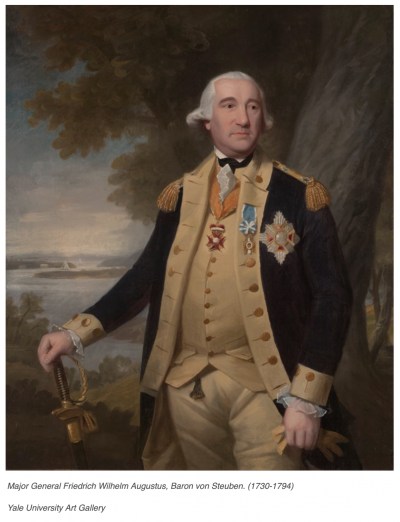1957 marked the first German-American Day Parade in Ridgewood Queens. General Friedrich von Steuben’s name was chosen as a patron for the parade because his birthday, September 17, was closest to the original German-American Day (first established on October 6, 1683). New York City, on the day of the parade, is filled with native costumes and bands. Grand Marshalls, such as Siegfried and Roy, Henry Kissinger, Eric Braeden, George Steinbrenner, Rudolph Giuliani, and George Pataki, have all been part of the three-hour parade. Although it is the largest ethnic parade in the United States, it doesn’t draw too much attention in the media.
General Friedrich von Steuben, was a major contributor to America’s independence. He was born in Magdeburg, Germany, on September 17, 1730, to Royal Prussian Engineer Captain Baron Wilhelm von Steuben and Elizabeth von Jagvodin. As a small boy, Friedrich accompanied his military father and followed him to battles in the Crimea and Kronstadt. He joined the army at age seventeen, serving as a Second Lieutenant in the Seven Years’ War (1756); was wounded at the Battles of Prague (1757) and in Kunersdorf, and rose to the post of aidede-camp to Frederick the Great. After these wars, von Steuben needed a salary. His contact with the future French Minister of War Claude Louis Comte de Saint-Germain in Hamburg in 1763 led him to Paris where he was introduced to Benjamin Franklin who was there to recruit military help for the American Revolution. However, the Continental Congress insisted on “volunteer” foreign military, therefore von Steuben headed for Prussia.
Once there, he faced allegations of his homosexual involvement with other officers. Although Frederick II was—in today’s language—“gay” himself, it was a punishable offense for everyone else. Von Steuben fled to America with his French “military secretary” Peter Etienne Du Ponceau, his Italian Greyhound “Azor”, and two male companions, where he landed in New Hampshire, and finally arrived at Valley Forge in Pennsylvania to join the Continental Army on February 5, 1778, with the promise of pay after the war.
Von Steuben – appointed by Washington as Inspector General – found an army living in borderline squalor, disorganization and desertion. Soon, he developed sanitation and camp design standards, exact record keeping, and inspections to combat rampant graft and theft. He standardized the rank system, uniforms, arms, and laid out the regulations for troop drilling.The major issue with the troops, however, was language. Von Steuben spoke little English – he gave orders in German to Du Ponceau, who translated them into French which were then transmitted to a French-speaking American who gave them back in English to Washington and were delivered the next morning to his troops.
Von Steuben’s “Regulations for the Order and Discipline of the Troops of the United States“ (Blue Book) was used by the United States Army until the Mexican-American War of 1846.He then became an American citizen in 1784, retiring with his longtime companion. After joining The German Reformed Church, he helped form the German Society of New York (1784) to aid German immigrants. Even though the U.S. Government supported the retired General, he was constantly in debt. In 1783, New Jersey gave him a house in River Edge (still standing), which he sold to pay his debts. Finally, the General settled in Duanesburg, and then in Rome, New York.
General Friedrich von Steuben died in 1794, leaving an incredible legacy behind. The “Von Steuben Day” celebrations have taken place every September, over many years, across the United States. The National Steuben Society was founded in 1919 to honor his legacy, and statures in his memory can be found in many in many parks across America. The annual parade gives German-Americans a chance to celebrate their ethnic contributions often ignored and forgotten due to the negative impact World War I and II left on their community.
Dr. Peter Lubrecht, www.olpeteshistoryalive.com
The German-American Steuben Parade
► is held annually on the third Saturday in September
► was founded in 1957 by German immigrants and German-Americans
► is named after General von Steuben whose training of the young American troops helped achieve victory against the British
► marches up Fifth Avenue to 86th Street and ends in Central Park with a big Octoberfest-style party
► is one of the most colorful parades in New York, with traditional costumes, stunning floats, marching bands and dancers.
► is a not-for-profit organization entirely based on donations from the German-American community.






